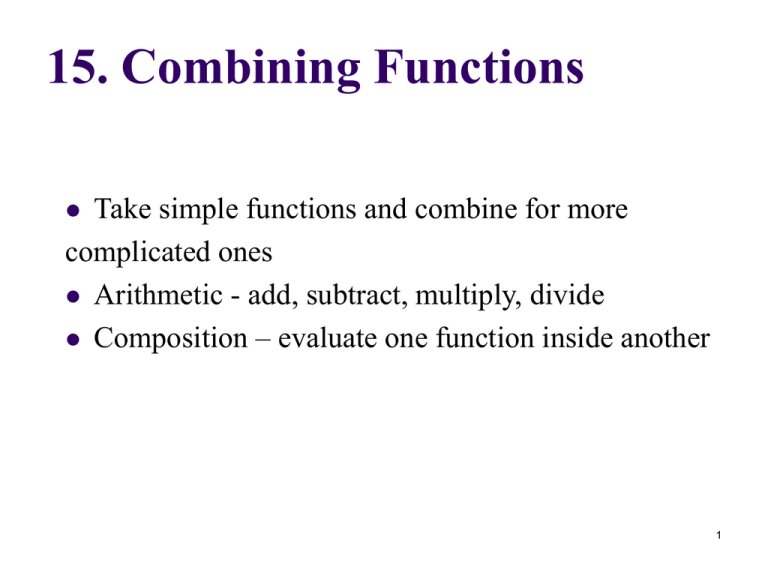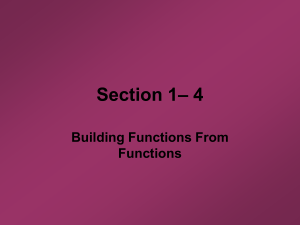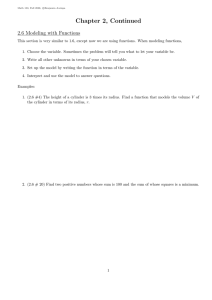1.1 Basic Equations
advertisement

15. Combining Functions Take simple functions and combine for more complicated ones Arithmetic - add, subtract, multiply, divide Composition – evaluate one function inside another 1 Arithmetic Combinations Given the functions: f ( x) x 5 and g ( x) x 2 ( f g )( x) Domain: ( f g )( x) Domain: ( fg )( x) Domain: f (x) g Domain: 2 Composition Evaluating one function using another function. ( f o g )( x) f ( g ( x)) 3 Example 1 Find the composition function: f ( x) 3 5 x 13 ( f o g )( x) and g ( x) 5 x 2 1 Domain: 4 Example 2 Find the composition function: x f ( x) x7 ( f o g )( x) and g ( x) 4 x 7 Domain: 5 Example 3 Evaluate for f ( x) 3 x 9 and g ( x) x 8 : f ( g (0)), g ( f (0)), ( f o f )( 1), and ( g o g )(3) f (g (0)) g ( f (0)) 6 Example 4 Use the graphs to evaluate: ( g o f )( 4) , ( f o g )(1) f (x ) 2 -3 -1 4 g ( x) -2 7 Application An airplane is flying 300 mi/hr at an altitude of 2 miles. At t = 0, the plane passes directly over a radar station. Express s as a function of d. d 2 s Express d as a function of t. Express s as a function of t. 8 16. Inverse Functions One-to-one functions: a function is one-to-one if every input is associated with one output and each output is associated with only one input. Horizontal Line Test – a function is one-to-one if and only if no horizontal line intersects the graph more than once. 9 Inverses Every one-to-one function, f(x), has an associated Function called an inverse function, f -1(x). The inverse function reverses what the function does. Its input is another function’s output. Its output is another function’s input. A 3 4 B 0 5 .77 -2 4 10 Example 1 f ( x) 5 x 2 f (8) 5(8) 2 42 f (0) 5(0) 2 2 1 f (17) ? 11 Finding Inverses Graphically Inverses swap x and y coordinates. 2 -3 f (x ) -1 4 -2 12 Finding Inverses Algebraically Three step process: 1. Write the equation y = f (x). 2. Solve the equation for x in terms of y. 3. Swap the x and y variables. The resulting equation is y = f -1(x). 13 Example 2 Find the inverse function for: f ( x) 3 x 2 f (x ) 14 Example 3 x Find the inverse function for: f ( x) x7 15 Inverse Property Functions f and f -1 have the following property : f 1 ( f ( x)) x f(f 1 ( x)) x f ( x) 3 x 2 16 17. Quadratic Functions Graph is a parabola. Either has a minimum or maximum point. That point is called a vertex. Use transformations on x2 and -x2 to get graph of any quadratic function. 17 Example 1 f(x) = x2: shift up 4 units and shift to the left 5 units 18 Standard Form For f ( x) ax 2 bx c the standard form is f ( x ) a ( x h) 2 k where (h, k ) is the vertex, and : 19 Example 2 Graph the function: f ( x) ( x 3) 5 2 Minimum value is Domain: Range: 20 Example 3 Graph the function: f ( x) ( x 4) 3 2 Maximum value is Domain: Range: 21 Example 4 Find the maximum or minimum value of the function. f ( x) x 2 14 x 24 Minimum value is x-intercepts = y-intercepts = 22 x value of the vertex For the general form : f(x) ax 2 bx c, b the vertex occurs at x . 2a b The extreme value (max or min) is f . 2a 23 Examples Find the maximum or minimum value of the functions. f ( x) 3x 2 6 x 11 g ( x) 5 x 2 4 x 2 24 18. Systems of Equations A set of equations involving the same variables A solution is a collection of values that makes each equation true. Solving a system = finding all solutions 25 Example 1 5 x 3 y 4 x 3y 2 Is (x, y) = (2, -2) a solution? Is (1, -1/3) a solution? 26 Substitution Method Pick one equation and solve for one variable in terms of the other. Substitute that expression for the variable in the other equation. Solve the new equation for the single variable and use that value to find the value of the remaining variable. 5 x 3 y 4 x 3y 2 27 Example 2 x y 25 2x y 0 2 2 28 Elimination Method Multiply both equations by constants so that one variable has coefficients that add to zero. Add the equations together to eliminate that variable. Solve the new equation for the single variable and use that value to find the value of the remaining variable. Example 3 3 x 5 y 20 x 3y 2 29 Example 4 3x 2 4 y 17 2 2 x 5y 2 30 19. Systems of Linear Equations A set of linear equations involving the two variables A solution is the intersection of the two lines. One of three things can happen: 31 Example 1 6 x 3 y 27 4 x 2 y 12 32 Example 2 5 x 10 y 25 2 x 4 y 10 33 Example 3 A chemist wants to mix a 20% saline solution with a 40% saline solution to get 1 liter of a 26% solution. How much of each should she use? (1 liter = 1000 ml) 34 Example 4 20 miles A boat travels downstream for 20 miles in 1 hour. It turns around and travels 20 miles upstream (against the current) in 1 hours and 40 minutes. What is the boat’s speed and how fast is the current? 35 Example 5 A woman invested in two accounts, one earned 2% and the other earned 10% in simple interest. She put twice as much in the lower-yielding account. If she earned $3500 in interest last year, how much was invested in each account? 36










